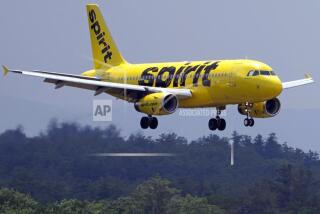Major Airlines Struggle in a Jet Stream of Change
- Share via
Three years after terrorists used jetliners as weapons and sent commercial aviation into its worst slump ever, the airline industry remains mired in red ink and is facing dramatic change.
With few exceptions, the major carriers are in critical shape. Most of the largest -- American, United, Delta, Northwest and US Airways -- are still losing money even though the summer is the airlines’ busiest season.
They have been pummeled by several jarring events since 2001, including the 9/11 terrorist attacks and this year’s surge in fuel prices. But beyond these shocks, many analysts and industry executives say, something even more fundamental is going on: The airlines’ traditional way of doing business is failing.
Since the attacks, the carriers have lost a collective $27 billion.
The growth of smaller, discount airlines such as Southwest, JetBlue and AirTran is one big factor. Their rise has cut into the larger airlines’ share of the market and has helped drive fares lower overall.
That has been good news for the nearly 650 million travelers who board domestic flights each year. But it has robbed the major carriers of their ability to raise prices to offset their enormous costs and stop the bleeding.
The result: The $77-billion airline industry -- a linchpin of the U.S. economy -- could be flying straight into its biggest shakeout in a decade, analysts say. It might start this fall and winter when passenger traffic declines and the airlines burn through what cash they have left.
The changes could mean a new round of bankruptcy filings, one or more airlines going out of business and further cost cutting. Additional job losses among the 570,000 people who still work for the domestic airlines -- 52,200 in California -- are widely expected.
For the public, the turmoil promises a reshuffling of which airlines serve which cities and how often. Flights to some smaller airports could be reduced or lost, at least for a time.
“Somebody is going to disappear, although at this point it’s hard to say who,” said Ron Kulhmann, an analyst at Unisys R2A Transportation Management Consultants in Oakland.
Delta Chief Executive Gerald Grinstein, announcing a huge overhaul of the Atlanta-based airline Wednesday, sounded even more downbeat: “What we’re now seeing is something that is so fundamentally different, there is no comparison to the past.
“This marketplace is at a very rapid state of change,” he added, and entering “a new era.”
Several carriers already are racing to restructure their operations and cut costs, but questions abound as to whether it’s too little, too late. Consider:
* United, the second-largest carrier behind American and the busiest airline at the Los Angeles and San Francisco airports, has been in Chapter 11 bankruptcy proceedings since late 2002. No one is sure when, or even if, it will emerge from its court- supervised reorganization. In the meantime, United has stopped contributing to its pension plans and indicated that more jobs cuts will be needed.
* US Airways, only 18 months out of Chapter 11 proceedings, is listing toward another bankruptcy filing and perhaps liquidation. Its next trip to U.S. Bankruptcy Court could come any day now, threatening its 11 daily departures from Los Angeles.
* Delta also is perilously close to filing for bankruptcy. The restructuring unveiled by the nation’s third-largest airline includes slashing as many as 7,000 jobs, or 10% of its workforce, in the next 18 months to save $5 billion a year. Yet “there remains a material risk” that Delta may have to file for Chapter 11 protection, possibly as soon next month, analyst Daniel McKenzie of Smith Barney said in a note to clients Thursday.
* Northwest and Continental Airlines, the No. 4 and 5 carriers, respectively, are struggling to break even. Continental, too, has stopped contributing to its pension plans for this year and expects to cut an additional 425 jobs as “continued losses jeopardize our survival,” Continental Chairman Gordon Bethune said last week.
* Alaska Airlines, saying the industry’s upheaval has “forced us to put aside notions of how we’ve historically operated,” said Thursday that it would close its Oakland maintenance base and other facilities, and contract out the work instead. Those moves, and a recent streamlining of its management, will eliminate about 900 of the airline’s 11,000 jobs.
With so many major carriers under severe pressure, some experts wonder how long it will be before one or more is grounded forever.
“We expect the next 12 months will see more change in the industry than the past three years combined,” said analyst William Greene of Morgan Stanley & Co.
All told, the struggling large airlines carry 1 in 2 domestic passengers, and the collapse of any single carrier probably would disrupt U.S. air travel, at least temporarily. When Pan American and Eastern disappeared in 1991, thousands of passengers were delayed even though other airlines agreed to honor their tickets.
“It could produce serious problems for travelers in the short run,” said Thom Nulty, a partner at Corporate Solutions Group, a travel management firm in Monarch Beach, Calif.
But he also noted that after Pan Am and Eastern shut down, air travel eventually climbed to record levels as their business was absorbed by other airlines.
In fact, the demise of an airline or two might help the industry stabilize as others get a boost in business, some observers say. And as long as an airline stays in bankruptcy proceedings, passengers’ frequent-flier mileage programs stay intact. United, for example, continues to honor its program.
“An airline would be crazy to alienate their very best customers” by dropping such incentives while in Chapter 11, Nulty said.
Although the 9/11 attacks battered the airlines by causing a severe drop in travel, they also uncovered the industry’s long-standing structural problems.
Before 1978, airlines were heavily regulated, down to the dinner menus they offered passengers. Then the business was thrown open to competition, enabling carriers to pick routes at available airports and set prices generally as they wished.
In the late 1990s, the major carriers were turning handsome profits as business travelers -- a roaring economy at their backs -- willingly paid high fares, such as $2,000 or more for a round-trip flight between Los Angeles and New York.
Labor unions also won rich new contracts from the carriers. The higher labor costs, along with other relatively high operating expenses, were more than offset by the airlines’ growing revenues.
But in the months leading to the terrorist attacks, the airlines saw their market mutate. With the economy drooping, business passengers stopped flying as much and suddenly balked at paying lofty fares.
The Internet and online travel services also made fares “transparent,” enabling both business and leisure fliers to easily search for the lowest prices. What’s more, discount airlines such as Southwest and JetBlue -- flying with much lower expenses -- expanded their service, forcing the older “network” airlines to match their cheaper prices or risk losing passengers.
“The low-cost carriers achieved a critical mass and offered enough seats in most markets to disrupt the pricing by the network carriers,” said William Rochelle, a partner and aviation specialist at law firm Fulbright & Jaworksi in New York.
The big airlines responded by slashing expenses, often by wringing more concessions from employees. Bitter fights with organized labor have erupted at several carriers, with the unions contending that they have sacrificed enough.
“Time and again, workers have given up millions in wages and benefits to help their carriers survive, only to see executives scapegoat them for their own financial ineptitude,” said David Kameras, spokesman for the Assn. of Flight Attendants, which represents 46,000 employees at 26 airlines.
There is occasional talk that airline mergers might help, but they are notoriously difficult to achieve. Melding many different labor contracts can be troublesome, as is winning federal antitrust approval. A combined carrier also would surely be saddled with an onerous debt burden. Finally, the airlines have little cash or stock price equity to offer as payment for one another.
If one or more airlines fails, the survivors would battle for the markets left behind -- shifting travelers’ choices.
Take US Airways: Although it’s perhaps the most troubled airline, it has valuable landing slots and gates at Ronald Reagan National Airport in Washington and LaGuardia Airport in New York.
“Just imagine what would happen to the competitive landscape at those airports if suddenly those gates and slots were available” to others, Rochelle said. “Talk about a catalyst for rapid change in the industry; that would be it.”
Mark Gerchick, director of the aviation program at George Washington University, cautioned that airlines historically have failed slowly and that the industry’s current woes could drag on awhile too.
Airlines affect so many people -- passengers, employees, suppliers, travel agents, airport workers -- that lenders often are reluctant to pull the plug, he noted. They hope instead that an airline can survive a bankruptcy reorganization, as did Continental and America West.
Politicians also don’t like to see airlines fail, disrupting travel and causing layoffs in their states. With the presidential election only weeks away, it’s unlikely that Washington would want an airline to go belly up before then.
Said Gerchick: “It takes a long, long time for an airline to die.”
More to Read
Inside the business of entertainment
The Wide Shot brings you news, analysis and insights on everything from streaming wars to production — and what it all means for the future.
You may occasionally receive promotional content from the Los Angeles Times.











